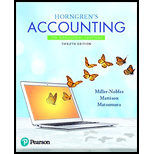
Concept explainers
Which of the following benefits of an effective
Learning Objective 1
a Flexibility
b. Relevance
c. Control
d. Compatibility
An Accounting Information System (AIS) is a process which collects data, processes the same into information, and distributes it to users. It is a tool which helps smoother decision making. The purpose of an accounting information system (AIS) is to collect, store, and process financial and accounting data and produce informational reports.
To determine:
Which benefit of the effective accounting information system provides safeguards for business assets and reduces the likelihood of fraud and errors?
Answer to Problem 1QC
Solution:
C. Control
Explanation of Solution
Explanations:
Given: Following choices are given:
a. Flexibility
b. Relevance
c. Control
d. Compatibility
Control assures that internal processes and procedures are implemented according to the standards set by the management. It Creates structure and encourages adherence to management procedures. Detects errors and frauds and also reduces chances of frauds and errors which may occur in future.
Objectives of Control: To safeguard the assets of the organization, to maintain records, to provide accurate & reliable information whenever required, to promote & improve operational efficiency, to encourage adherence to prescribed policies, to comply with applicable laws & regulations and to detect errors and frauds.
Other benefits of accounting information system serve for following:
Flexibility: Facilitates the business to accommodate with the changes madein the business over time or contingencies which may occur in future.
Relevance: It refers to the relation of the information with the subject matter. It saves time by reducing irrelevant information.
Compatibility: It facilitates compatibility between employees and structure of the organization.
Thus, among all the given benefits of the effective accounting information system, CONTROL provides safeguards for business assets and reduces the likelihood of fraud and errors.
Want to see more full solutions like this?
Chapter 7 Solutions
Horngren's Accounting (12th Edition)
Additional Business Textbook Solutions
Principles of Economics (MindTap Course List)
MARKETING:REAL PEOPLE,REAL CHOICES
Management (14th Edition)
Horngren's Cost Accounting: A Managerial Emphasis (16th Edition)
Financial Accounting: Tools for Business Decision Making, 8th Edition
- For each of the transactions above, indicate the amount of the adjusting entry on the elements of the balance sheet and income statement.Note: Enter negative amounts with a minus sign.arrow_forwardNeed help with this question solution general accountingarrow_forwardDon't use ai given answer accounting questionsarrow_forward
- I want to correct answer general accounting questionarrow_forwardKindly help me with accounting questionsarrow_forwardDuo Corporation is evaluating a project with the following cash flows: Year 0 1 2 3 Cash Flow -$ 30,000 12,200 14,900 16,800 4 5 13,900 -10,400 The company uses an interest rate of 8 percent on all of its projects. a. Calculate the MIRR of the project using the discounting approach. Note: Do not round intermediate calculations and enter your answer as a percent rounded to 2 decimal places, e.g., 32.16. b. Calculate the MIRR of the project using the reinvestment approach. Note: Do not round intermediate calculations and enter your answer as a percent rounded to 2 decimal places, e.g., 32.16. c. Calculate the MIRR of the project using the combination approach. Note: Do not round intermediate calculations and enter your answer as a percent rounded to 2 decimal places, e.g., 32.16. a. Discounting approach MIRR b. Reinvestment approach MIRR c. Combination approach MIRR % % %arrow_forward
 Auditing: A Risk Based-Approach to Conducting a Q...AccountingISBN:9781305080577Author:Karla M Johnstone, Audrey A. Gramling, Larry E. RittenbergPublisher:South-Western College Pub
Auditing: A Risk Based-Approach to Conducting a Q...AccountingISBN:9781305080577Author:Karla M Johnstone, Audrey A. Gramling, Larry E. RittenbergPublisher:South-Western College Pub Auditing: A Risk Based-Approach (MindTap Course L...AccountingISBN:9781337619455Author:Karla M Johnstone, Audrey A. Gramling, Larry E. RittenbergPublisher:Cengage LearningPrinciples of Accounting Volume 2AccountingISBN:9781947172609Author:OpenStaxPublisher:OpenStax College
Auditing: A Risk Based-Approach (MindTap Course L...AccountingISBN:9781337619455Author:Karla M Johnstone, Audrey A. Gramling, Larry E. RittenbergPublisher:Cengage LearningPrinciples of Accounting Volume 2AccountingISBN:9781947172609Author:OpenStaxPublisher:OpenStax College- Principles of Accounting Volume 1AccountingISBN:9781947172685Author:OpenStaxPublisher:OpenStax College
 Accounting Information SystemsAccountingISBN:9781337619202Author:Hall, James A.Publisher:Cengage Learning,
Accounting Information SystemsAccountingISBN:9781337619202Author:Hall, James A.Publisher:Cengage Learning, Cornerstones of Financial AccountingAccountingISBN:9781337690881Author:Jay Rich, Jeff JonesPublisher:Cengage Learning
Cornerstones of Financial AccountingAccountingISBN:9781337690881Author:Jay Rich, Jeff JonesPublisher:Cengage Learning





